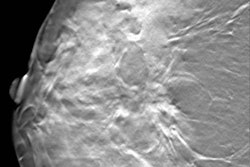Five years ago, Denise Bacon had just started her new job at a diagnostic breast center when she received the results of the facility's Gallup patient satisfaction survey. She was shocked. According to the numbers, the overall customer satisfaction rate was a dismal 30%.
"When I presented the results to our staff, they said it had to be a mistake. Something (was) wrong," said Bacon, who is at the Breast Diagnostic Center at Clear Lake Regional Medical Center in Webster, TX.
She suspected that staff might be right -- after all, the facility had a solid referral base and equipment, two radiologists fellow-trained in breast imaging, and experienced and dedicated support staff. In addition, it always passed Mammography Quality Standards Act (MQSA) inspections with flying colors, and the staff believed that they provided excellent service.
"I said, 'Let's keep an eye on it and see how we do next quarter,'" Bacon said.
However, when subsequent quarterly results rolled in, they learned that the numbers were no mistake. Bacon set out to determine why. Her review of patient surveys quickly revealed that the answer was right in the waiting room where patients sat, growing ever more frustrated by long wait times.
"The first thing I found out is that patients don't like to wait, and if they do have to wait, they want to know why they have to wait," Bacon said.
Bacon decided that the first step toward improvement was a closer assessment of the problem. Bacon used existing patient questionnaires that were color-coded -- pink for screening patients, yellow for diagnostic patients, and blue for male patients -- so that she could quickly review results without having to look up patient history. Each sheet was initialed by every employee who treated the patient to provide additional insight.
Bacon discovered that the problem was patient flow. An investigation into the complaints revealed that the registration process often took longer than the mammogram itself. Patients weren't registered until 15-20 minutes after their appointment times and this, along with redundant processes, caused additional delays.
Registration issues
One of the first areas she and her staff targeted was patient registration. The breast center registered patients using a standard inpatient admission process, which addresses topics such as advance directives and blood transfusions -- information that is largely unnecessary when a woman comes in for a noninvasive exam.
"We worked with our legal and financial departments to whittle away the (admission) process," Bacon said.
They also looked for redundant processes. For example, they found that patients filled out mammography reporting system forms as part of the registration process and that the technologists asked the same questions once patients went in for their exams. They eliminated this portion from the registration process because it was more appropriate for technologists to obtain this information.
"We took as much work away from the front desk as we possibly could without placing it back on the technologists," Bacon said.
Interdepartmental collaboration
Making the changes was anything but straightforward. Bacon didn't oversee the registration staff. They were part of the patient account services department, so she had to work with that department director to gain support and make changes.
Bacon encountered the same issue regarding scheduling. The scheduling department was located offsite and scheduled all imaging exams for two hospitals. Initially, the scheduling department was hesitant to incorporate mammography exam-specific queries because it had so many other areas of focus. Bacon worked with the department's supervisor to analyze the schedulers' workload.
They found that breast imaging services constituted an average of 35% of the schedulers' total workload between two facilities. This number caught the attention of higher-ups.
Bacon moved to revise the scheduling questionnaire and begin offering inservices for the scheduling staff to help them understand the effect they had on patient care.
"Their efforts have allowed us to utilize our resources much more efficiently," she said. "It's not perfect, but it's 75% better than what it was."
Tracking progress
Another step they took to improve patient satisfaction was implementing a patient tracking system, written on a large white board in the center of the department. Staff recorded where each patient was in the process and who was working with that patient. This not only helped to track the amount of time for which patients waited, but it also reduced issues with locating patients or determining who was working with them.
The facility also invested in a formal computerized patient tracking system. This allowed staff to see where patients were in the system and how long they had to wait, and helped them find flaws in the process.
The staff was initially resistant to this tracking system, she said. They saw it as a punitive step, one designed to lay blame on them for efficiency failures.
"Nobody likes to be told that (he or she) could be doing a better job," Bacon noted.
She and the patient account services director tried to help staff understand that the goal was to improve patient care, not to point fingers.
Despite the resistance, wait times diminished and customer satisfaction scores began to rise. However, sometimes a wait is inevitable, such as in the case of a diagnostic patient who experiences delays while the recommendation is made to initiate further testing (e.g., an ultrasound).
They found that the best way to head off customer dissatisfaction in these instances was to keep the lines of communication open.
"We developed a lot of educational material for patients to let them know what to expect while they were in the facility," Bacon said.
The facility also provided additional training to technologist assistants. They were often the first staff to communicate with the patient and were therefore responsible for providing accurate information and making patients feel at ease during their exams.
Radiologists' reaction
Another group with whom Bacon worked to improve patient flow was the radiologists.
"It was a challenge to tell the radiologists that some of the inefficiencies in the department were built around radiologists' preferences," she said.
This was particularly true because her radiologists were fellowship-trained and well-regarded. Unlike many radiologists, they also regularly made it a point to speak with patients directly and for that reason had a loyal customer base.
However, problems arose that had nothing to do with the quality of the radiologists' work. Rather, they resulted from radiologists performing the same tasks in different ways, which made them less efficient.
For example, one radiologist preferred to read films in her office, while another read hers in the control area. This wouldn't have presented a problem except that staff could not find efficient ways to handle these preferences while improving workflow.
"The radiologists were willing to listen to our suggestions, but we had the burden of proving (that) the changes were to benefit the patient," Bacon said. Together, changes were initiated, and overall efficiency has since improved.
The results
The breast center has maintained customer satisfaction rates at 98% to 99% for four quarters now. In addition, it has managed to sustain its volume even as other outpatient imaging service volumes have dropped. However, one of Bacon's biggest regrets about this process is that she didn't come up with more creative ways to recognize staff for their work.
"It was a very hard thing. I could have done a better job," Bacon said.
Many aspects of the changes were difficult for staff, such as the tracking system that made them feel as though they were being watched and the patient feedback questionnaires.
Bacon tried to portray the questionnaires as positive by showcasing complimentary comments during monthly staff meetings.
After three consecutive quarters of reaching their goal, staff eventually convinced Bacon to discontinue the cards -- albeit with the provision that they will be reinstituted if customer satisfaction numbers start to drop, she said.
It was a small concession for a staff that has weathered a lot of changes and is directly responsible for remarkable gains in patient satisfaction, Bacon said. Although staff may have been reluctant to embrace the changes initially, she said they have definitely seen the payoff.
"I just pointed to the direction (in which) we wanted to go," Bacon said. "However, staff made those changes a reality."
By Kelly Bilodeau
AuntMinnie.com contributing writer
March 28, 2006
The "Mammography Regulation and Reimbursement Report," is a 12-page monthly newsletter designed specifically for mammographic technologists and supervisors that is published by HC Pro. The periodical offers ideas for better practice management from peers, billing tips, MQSA regulatory updates and guidance, and business ideas related to breast imaging. For a free trial subscription, please click here.
Related Reading
Referral physician relationships drive imaging center success, November 25, 2005
Successful customer service requires scrutiny, October 17, 2005
Service blueprinting maps path to excellence, August 26, 2005
Strong customer relationships: Building a competitive advantage, June 6, 2005
Customer service begins at the top, November 22, 2002
Copyright © 2006 HC Pro



















